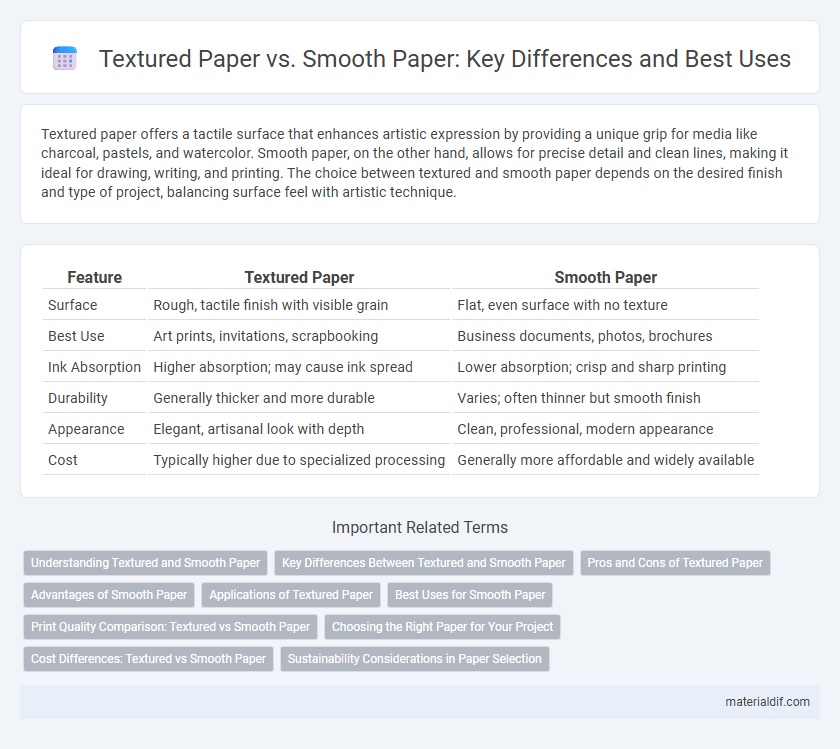Textured paper offers a tactile surface that enhances artistic expression by providing a unique grip for media like charcoal, pastels, and watercolor. Smooth paper, on the other hand, allows for precise detail and clean lines, making it ideal for drawing, writing, and printing. The choice between textured and smooth paper depends on the desired finish and type of project, balancing surface feel with artistic technique.
Table of Comparison
| Feature | Textured Paper | Smooth Paper |
|---|---|---|
| Surface | Rough, tactile finish with visible grain | Flat, even surface with no texture |
| Best Use | Art prints, invitations, scrapbooking | Business documents, photos, brochures |
| Ink Absorption | Higher absorption; may cause ink spread | Lower absorption; crisp and sharp printing |
| Durability | Generally thicker and more durable | Varies; often thinner but smooth finish |
| Appearance | Elegant, artisanal look with depth | Clean, professional, modern appearance |
| Cost | Typically higher due to specialized processing | Generally more affordable and widely available |
Understanding Textured and Smooth Paper
Textured paper features a raised or embossed surface that enhances tactile sensation and visual depth, making it ideal for artistic applications and premium printing. Smooth paper offers a flat, even surface providing consistent ink absorption and sharp image reproduction, preferred for detailed text and high-resolution prints. Understanding the differences helps in selecting the right paper type based on project requirements such as print clarity, finish quality, and intended use.
Key Differences Between Textured and Smooth Paper
Textured paper features a raised or embossed surface that enhances tactile experience and adds visual depth, making it ideal for artistic projects and invitations. Smooth paper offers a flat, even surface that facilitates crisp printing and precise detail, commonly used in professional documents and high-quality photo prints. The choice between textured and smooth paper depends on the desired aesthetic, printing method, and project purpose, with textured paper emphasizing artistic effect and smooth paper prioritizing clarity and color accuracy.
Pros and Cons of Textured Paper
Textured paper offers enhanced tactile appeal and richness, making it ideal for artistic projects like watercolor paintings and invitations due to its ability to hold pigments and create depth. However, textured surfaces can cause difficulties in writing with fine-tipped pens and may result in uneven printing or scanning quality. While smooth paper excels in clarity and precision for text-heavy documents, textured paper provides a unique aesthetic at the expense of some functional convenience.
Advantages of Smooth Paper
Smooth paper offers superior print clarity and sharpness, making it ideal for high-resolution images and detailed text. Its non-absorbent surface ensures vibrant colors and prevents ink bleeding, enhancing overall print quality. Smooth paper also provides a sleek, professional appearance suitable for presentations and formal documents.
Applications of Textured Paper
Textured paper enhances visual appeal and tactile experience, making it ideal for artistic applications such as watercolor painting, sketching, and printmaking where surface grip impacts medium adherence. It is preferred in luxury packaging and invitations, as the raised patterns convey elegance and sophistication that smooth paper lacks. Textured paper also improves ink absorption and reduces smudging, benefiting calligraphy and handcrafted greeting cards.
Best Uses for Smooth Paper
Smooth paper is ideal for detailed ink work, fine line illustrations, and professional printing due to its even surface that allows for precise strokes and sharp text. It excels in digital printing and graphic design projects where clarity and color accuracy are critical. Smooth paper also supports handwriting and calligraphy by providing a consistent texture that prevents ink bleeding.
Print Quality Comparison: Textured vs Smooth Paper
Textured paper enhances print quality by adding depth and a tactile element, ideal for artistic prints and photographs requiring rich detail and dimensionality. Smooth paper, in contrast, delivers sharper, more precise prints with vibrant colors and fine lines, making it perfect for graphic designs, text documents, and high-resolution images. The choice between textured and smooth paper depends on desired visual effects and the type of printer used, impacting ink absorption and overall print fidelity.
Choosing the Right Paper for Your Project
Textured paper offers a tactile surface that enhances artistic projects requiring depth and dimension, making it ideal for watercolor and pastel artwork. Smooth paper provides a sleek finish suitable for detailed, precise work such as digital printing and pen sketches. Selecting the right paper depends on the desired visual effect, medium compatibility, and the project's presentation needs.
Cost Differences: Textured vs Smooth Paper
Textured paper typically costs more than smooth paper due to its manufacturing process involving additional embossing or coating techniques that enhance tactile and visual appeal. Smooth paper benefits from simpler production methods, resulting in lower material and labor costs, making it more budget-friendly for bulk printing projects. Choosing between textured and smooth paper depends on budget constraints and the desired aesthetic impact of the printed materials.
Sustainability Considerations in Paper Selection
Textured paper often requires less chemical processing and fewer coatings, contributing to a lower environmental impact compared to smooth paper, which typically undergoes extensive refining and finishing treatments. The production of textured paper can utilize recycled fibers more effectively, enhancing sustainability by reducing waste and resource consumption. Choosing textured paper supports eco-friendly practices by minimizing energy use and promoting biodegradable, non-toxic materials in printing and packaging applications.
Textured Paper vs Smooth Paper Infographic

 materialdif.com
materialdif.com